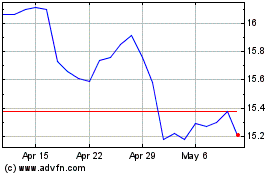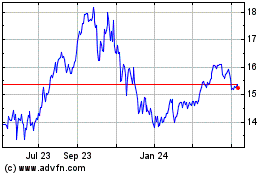The Key to Investing in a Futures Backed ETF - ETF News And Commentary
April 29 2013 - 9:00AM
Zacks
As the global equity markets become more and more integrated
thanks to globalization, investors have been looking into other
asset classes for diversification benefits. In this process, they
often tend to overlook the crucial aspects of investing in these
products and most of the time end up getting burned.
Commodities are one such asset class that provide a reasonable
amount of diversification from equities. However, they might also
exhibit strong positive correlation depending upon various
macroeconomic developments.
For example, equities and commodities both surged on the Federal
Reserve’s announcement of a third round of quantitative
easing, the QE3.
Nevertheless, commodity ETFs are the easiest way of gaining
exposure to the natural resource space. However, most of the
products provide an exposure in the underlying commodity via
futures backed route.
This is in contrast to those that actually invest in the
commodity and hold it securely—like with what we see in the gold
and silver markets. While this might seem like a minor
detail, it can have serious consequences on the profit (or
loss) incurred by the investors (read Volatility ETFs: Three
Factors Investors Must Know).
The effect of Contango is by far the
single biggest factor that investors must consider before investing
in any futures backed product. The futures curve under ordinary
circumstances will be upward rising.
However, in a market with contango, the front months’ contracts
are less expensive than those in the far months. Most of these ETPs
will therefore roll over positions from the front month contracts
to one in the far month (i.e. sell high, buy higher) in order to
avoid physical delivery. This causes an ETP to lose money every
time it rolls over its position (see Natural Gas ETFs: Futures vs.
Equities).
While contango is generally associated with a situation of
oversupply and falling spot prices of the underlying commodity,
surprisingly, the effect of contango can eat up fund return even if
the underlying commodity has ended on a positive note for the
period of time under consideration. To highlight this effect, two
futures backed Energy Commodity ETFs have been chosen.
The PowerShares DB Oil ETF
(DBO) and the
United States Oil ETF
(USO) are two such ETFs
which track Oil futures and employ the roll over methodology to
track the performance of spot Oil prices. And needless to say,
these are susceptible to contango.
These two Oil ETFs provide a pure play in the oil segment in
contrast to the Energy Select Sector SPDR ETF
(XLE) which tracks the
stock market performance of companies engaged from the broader
energy sector of the U.S equity markets. Although they somewhat
track the same segment, their performance trends are very
different.
In fact, a closer analysis suggests that the pure play ETFs i.e.
USO and DBO have a very strong correlation with the performance of
crude oil as measured by WTI Crude prices. In fact the chart below
goes to show the extent of the strong correlation of the futures
backed ETFs in contrast to the equity ETF with WTI Crude (read Time
to Return to Uranium ETFs?).

As we can clearly see, the correlation between the futures
backed ETF and WTI Crude has seldom dropped below 80%. In fact on
the contrary, most of the time their correlation tends to exceed
90%. However, when it comes to the performance evaluation of the
ETPs compared to WTI crude, a very interesting fact is
revealed.
In the trailing one year time frame, WTI Crude has been beaten
down a bit, starting at $104/bbl, moving widely, but finishing the
time frame right around $94/bbl or a roughly 10% loss. However, we
have not seen the same thing in the oil or energy ETF market by any
means.
For the same time frame XLE has returned around 11.7%, however,
DBO and USO have slumped by 13.6% and 15.5% respectively.
This has happened primarily due to the recent technological
developments which have increased the extraction and production of
energy products as well as weak macroeconomic cues which have
decreased the demand for industrials fuels. This situation has
paved the way for a classic case of oversupply for the commodity
which is the primary reason for contango across the futures curve
(see Best ETFs to Start 2013).
However, it is worthwhile to note that the reason for a higher
loss in USO compared to DBO is the fact that USO seeks to roll over
positions on a daily basis which magnifies the effect of contango.
DBO also uses a methodology which seeks to minimize the effect of
contango when the contracts are rolled over.
This is reflected in the expense ratios for these two funds
where the slightly actively managed DBO charges 0.79% compared to
USO charging 45 basis points annually in fees and expenses.
However, it is also worthwhile to point out that the strategy for
DBO has gone a long way in reducing losses for its investors (read
Three Surging ETFs with Strong Momentum).
Given the above effects of contango in returns for the futures
backed ETPs, it might well be the single biggest factor to consider
for investors seeking the futures route to gain access in the
underlying asset class, and especially with ETFs.
Want the latest recommendations from Zacks Investment Research?
Today, you can download 7 Best Stocks for the Next 30
Days. Click to get this free report >>
PWRSH-DB OIL FD (DBO): ETF Research Reports
US-OIL FUND LP (USO): ETF Research Reports
SPDR-EGY SELS (XLE): ETF Research Reports
To read this article on Zacks.com click here.
Zacks Investment Research
Want the latest recommendations from Zacks Investment Research?
Today, you can download 7 Best Stocks for the Next 30 Days. Click
to get this free report
Invesco DB Oil (AMEX:DBO)
Historical Stock Chart
From Dec 2024 to Jan 2025

Invesco DB Oil (AMEX:DBO)
Historical Stock Chart
From Jan 2024 to Jan 2025
